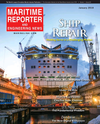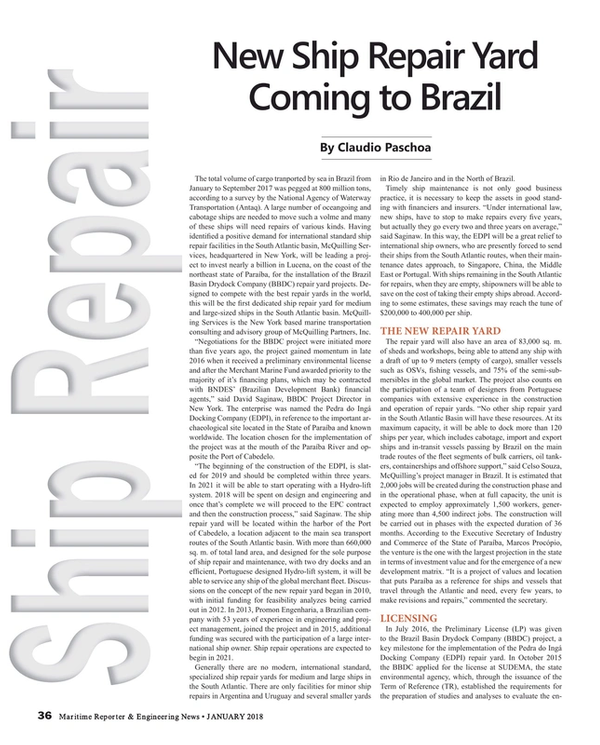The total volume of cargo tranported by sea in Brazil from January to September 2017 was pegged at 800 million tons, according to a survey by the National Agency of Waterway Transportation (Antaq). A large number of oceangoing and cabotage ships are needed to move such a volme and many of these ships will need repairs of various kinds. Having identified a positive demand for international standard ship repair facilities in the South Atlantic basin, McQuilling Services, headquartered in New York, will be leading a project to invest nearly a billion in Lucena, on the coast of the northeast state of Paraíba, for the installation of the Brazil Basin Drydock Company (BBDC) repair yard projects. Designed to compete with the best repair yards in the world, this will be the first dedicated ship repair yard for medium and large-sized ships in the South Atlantic basin. McQuilling Services is the New York based marine transportation consulting and advisory group of McQuilling Partners, Inc.
“Negotiations for the BBDC project were initiated more than five years ago, the project gained momentum in late 2016 when it received a preliminary environmental license and after the Merchant Marine Fund awarded priority to the majority of it’s financing plans, which may be contracted with BNDES’ (Brazilian Development Bank) financial agents,” said David Saginaw, BBDC Project Director in New York. The enterprise was named the Pedra do Ingá Docking Company (EDPI), in reference to the important archaeological site located in the State of Paraíba and known worldwide. The location chosen for the implementation of the project was at the mouth of the Paraíba River and opposite the Port of Cabedelo.
“The beginning of the construction of the EDPI, is slated for 2019 and should be completed within three years. In 2021 it will be able to start operating with a Hydro-lift system. 2018 will be spent on design and engineering and once that’s complete we will proceed to the EPC contract and then the construction process,” said Saginaw. The ship repair yard will be located within the harbor of the Port of Cabedelo, a location adjacent to the main sea transport routes of the South Atlantic basin. With more than 660,000 sq. m. of total land area, and designed for the sole purpose of ship repair and maintenance, with two dry docks and an efficient, Portuguese designed Hydro-lift system, it will be able to service any ship of the global merchant fleet. Discussions on the concept of the new repair yard began in 2010, with initial funding for feasibility analyzes being carried out in 2012. In 2013, Promon Engenharia, a Brazilian company with 53 years of experience in engineering and project management, joined the project and in 2015, additional funding was secured with the participation of a large international ship owner. Ship repair operations are expected to begin in 2021.
Generally there are no modern, international standard, specialized ship repair yards for medium and large ships in the South Atlantic. There are only facilities for minor ship repairs in Argentina and Uruguay and several smaller yards in Rio de Janeiro and in the North of Brazil.
Timely ship maintenance is not only good business practice, it is necessary to keep the assets in good standing with financiers and insurers. “Under international law, new ships, have to stop to make repairs every five years, but actually they go every two and three years on average,” said Saginaw. In this way, the EDPI will be a great relief to international ship owners, who are presently forced to send their ships from the South Atlantic routes, when their maintenance dates approach, to Singapore, China, the Middle East or Portugal. With ships remaining in the South Atlantic for repairs, when they are empty, shipowners will be able to save on the cost of taking their empty ships abroad. According to some estimates, these savings may reach the tune of $200,000 to 400,000 per ship.
The New Repair Yard
The repair yard will also have an area of 83,000 sq. m. of sheds and workshops, being able to attend any ship with a draft of up to 9 meters (empty of cargo), smaller vessels such as OSVs, fishing vessels, and 75 percent of the semi-submersibles in the global market. The project also counts on the participation of a team of designers from Portuguese companies with extensive experience in the construction and operation of repair yards. “No other ship repair yard in the South Atlantic Basin will have these resources. At its maximum capacity, it will be able to dock more than 120 ships per year, which includes cabotage, import and export ships and in-transit vessels passing by Brazil on the main trade routes of the fleet segments of bulk carriers, oil tankers, containerships and offshore support,” said Celso Souza, McQuilling’s project manager in Brazil. It is estimated that 2,000 jobs will be created during the construction phase and in the operational phase, when at full capacity, the unit is expected to employ approximately 1,500 workers, generating more than 4,500 indirect jobs. The construction will be carried out in phases with the expected duration of 36 months. According to the Executive Secretary of Industry and Commerce of the State of Paraíba, Marcos Procópio, the venture is the one with the largest projection in the state in terms of investment value and for the emergence of a new development matrix. “It is a project of values and location that puts Paraíba as a reference for ships and vessels that travel through the Atlantic and need, every few years, to make revisions and repairs,” commented the secretary.
Licensing
In July 2016, the Preliminary License (LP) was given to the Brazil Basin Drydock Company (BBDC) project, a key milestone for the implementation of the Pedra do Ingá Docking Company (EDPI) repair yard. In October 2015 the BBDC applied for the license at SUDEMA, the state environmental agency, which, through the issuance of the Term of Reference (TR), established the requirements for the preparation of studies and analyses to evaluate the environmental impacts of the project. The documentation of the EIA/RIMA (Environmental Impact Study/Environmental Impact Report) was prepared by Real Consultoria e Soluções and submitted to SUDEMA in April 2016. The public hearing of the project was held in Lucena in early June 2016, and in July all required approvals were issued. The LP concession certifies the environmental viability of the project and marked an important step for the EDPI project regarding the transition between its planning and execution. At the time BBDC’s project manager for the implementation of the EDPI shipyard, Celso Souza, stated: “In the EDPI project team in Paraíba, Rio de Janeiro and New York, everyone is very enthusiastic about this result”, and also noted: “We have reached an important goal for the development of the project, but we recognize that there is still a lot to do.” According to Saginaw, “The preliminary license was a key point for us. Based on the results of the initial environmental studies we conducted, we expected to get the license, but it was important to have it on hand to provide security to the process of financing the project. We have talked with several regional actors achieving good results, and now we are intensifying the discussions with interested investors, both in Brazil and abroad. We are advancing on several fronts with potential strategic partners who are interested in the project. We are confident in the project - as well as on the overall picture of the country, which has passed a critical point along the way, and we are optimistic that we will be able to start the works in 2019, with the first repairs services already provided in 2021.”
Financing
The board of directors of the Merchant Marine Fund (FMM), at Brazil’s Ministry of Transport, Ports and Civil Aviation, has granted its approval to provide R$2.15 billion in finance to build the new ship repair facility in the country. As part of the deal, the BBDC will use the basis fund to construct the EDPI ship repair yard facility. The new ship repair facility will be constructed as part of an R$9.15 billion program for new and existing government projects. Additionally, the latest approval has enabled BBDC to contract the financing of $635 million with its already agreed financial agent, the Brazilian Development Bank (BNDES). Both the equity investors and the banks seek comfort from a predicable revenue stream, which EDPI’s potential for attracting, international ship owners, in need of ship repairs appears to guarantee.
Demand
“Apart from drydocking, vessels require ship repair yards for fixing collision damage, grounding damage, severe weather damage as well as newbuilding faults and installation of capital items (BWT systems, Scrubbers, etc.). The vast majority of ship drydocking and repair contracts are negotiated on a spot basis, making the investment decision dependent on an extremely robust characterization and quantification of drydocking demand,” explained David Saginaw. Four factors play a major role in winning the repair contract: proximity, price, promptness and performance. The EDPI yard primarily targets the global merchant marine fleets that require a repair yard of international standard, which can accommodate a full range of repair services, with high quality standards and quick service. It is estimated over 90 percent of drydocking and ship repair revenues for the EDPI will be denominated in U.S. dollars, sourced from international ship owners. It is forecasted that there will be a growing regional market potential though cabotage and OSV repairs. With the ongoing development of the adjacent Equatorial Margin oil and gas exploration projects, the number of ships of all sizes needing repair in the region is guaranteed to grow. Even with some large newly built local shipyards gravitating to ship repair due to the scarcity of new ship orders, it is perceived that EDPI will still be a competitive facility due to location, design and modern work processes and the largest facility in the South Atlantic basin, purpose built for ship repair and drydocking.



